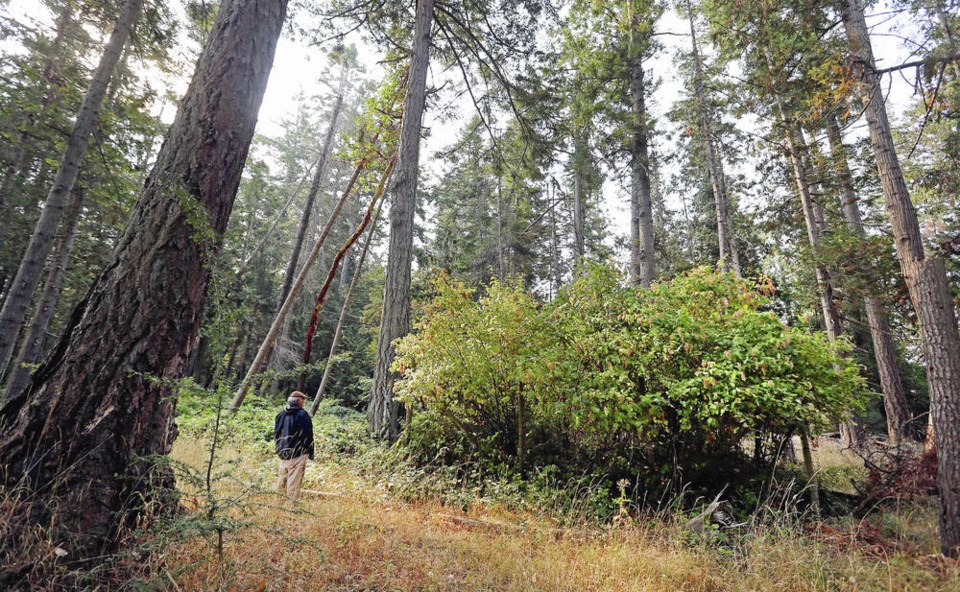The mass killing of fallow deer by sharpshooters in helicopters and hunters on land with tracking dogs is expected to start between Nov. 25 and Dec. 15 on Sidney Island and continue for several days, according to Parks Canada.
That has prompted a rally on Friday at Sidney’s Beacon Park protesting the “inhumane” tactics and $5.9-million cost to eradicate the invasive species from the tiny island just a few kilometres from Sidney’s shores.
The goal of the 1 p.m. gathering, according to organizer Sharon Glynn, is to stop the “unscientific and costly” eradication or at least postpone the killings until more research is done.
Parks Canada said Thursday it has completed an operational plan with First Nations partners and its contractor, Coastal Conservation, and the deer kill is going ahead.
The initial phase is expected to start over 10 days at the end of the month, with a second roundup and kill to be done a year later, it said.
Opponents, including Glynn and David Bird, emeritus professor of wildlife biology at McGill University and a resident of North Saanich, were meeting with Parks Canada staff and Gulf Islands MP Elizabeth May late Thursday to see if the project could be delayed pending further research, but it seemed doubtful.
The deer kill is aimed at restoring native plants and biodiversity on the island, which is partly parkland and partly privately owned, after years of damage by deer. Parks Canada says the contract covers the project to 2026 and includes removal of invasive plants and replanting of native species.
But Bird, who plans to join the protest, said the costly contract is a waste of taxpayers’ money when traditional hunting has already significantly thinned the population.
Parks Canada has admitted the exact fallow deer population isn’t known but provided a broad estimate of between 300 and 900 animals, based on counts by two residents, neither of whom are biologists, said Bird.
“Using an arguably generous estimate of about 400 deer, that works out to almost $15,000 per animal,” said Bird, who spent 30 years teaching wildlife management at McGill.
“The organized humane hunts that cost the public literally nothing are clearly working, so what is the big rush?”
Bird, who has been part of fallow deer hunts on the Island for years — including this fall — said those hunts have winnowed the population from a high of 2,000 to 2,500 animals a decade ago to likely no more than 300 today.
He credits Sidney Island residents who own 1,500 hectares in 111 bare-land-strata lots for initiating the well-organized hunts and culls that successfully reduced the numbers.
Lack of deer sightings and deer feces this fall shows the population is on the decline, and probably no more than 100 to 200 animals, the majority of which likely live on private land where hunters can’t go, he said.
“However, to date there has been no proper, science-based censuses of the deer population on the island, which you would think is where you would start all of this.”
Bird said between 2005 and 2012, Ottawa spent $5.6 million to tackle 140 different invasive plants and animals — yet the Sidney Island deer kill exceeds that total.
He cites a 2019 study on Sidney Island by the University of British Columbia showing that as deer populations were reduced “native species richness and diversity nearly doubled, and native plant cover increased by 30%, from 2013 to 2019.”
The UBC study also observed increases in the “cover, richness, and diversity of palatable and culturally significant woody shrub and tree species” as fallow deer populations fell.
Kate Humble, superintendent of Gulf Islands National Park Reserve, said Thursday an exact census of the deer population “isn’t important when you’re eradicating the [entire] population in an enclosed environment” like Sidney Island.
Several of the fallow deer to be taken in the first phase of shootings, and Humble said the majority of effort by the hunters will be spent finding and eliminating what remains of population in the second phase.
Coastal Conservation has contracted a helicopter and is bringing in marksmen from the U.S. and New Zealand who are trained in aerial and ground hunting and will only take shots if their targets are clear and assured, said Humble.
Humble said there will be no hunting by helicopter at night, though ground-based marksmen will be active during darkness when fallow deer are most active.
Email and text notices of when the shootings will happen will be sent out to residents of the island and nearby islands, she said.
First Nations will be on Sidney Island during the kill as harvesting crews, Parks Canada said. They have been trained to skin and butcher the deer and refrigerated units will be on hand to store the meat for eventual distribution to families in the region.
The B.C. SPCA will also have a representative on the island during the mass shootings to ensure humane kills, said Humble.
Nearly all of Sidney Island will be open to the hunt, said Humble, including the Parks Canada and Islands Trusts property as well as common land shared by residents. The only part closed to hunting will be the private lots of property owners.



